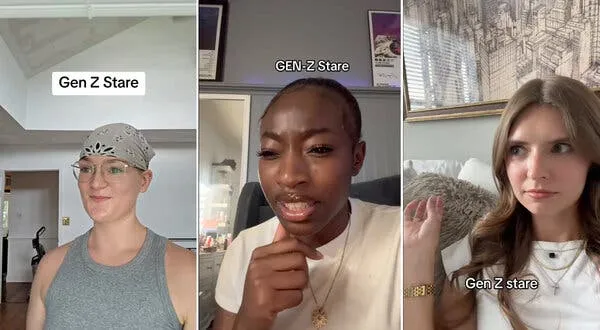The Gen Z Stare: A New Form of Non-Verbal Communication?
In recent weeks, a peculiar trend known as the “Gen Z Stare” has emerged as a topic of debate on social media platforms like TikTok. This staring phenomenon is not merely a trend but seems to encapsulate a growing generational divide in communication styles. But what exactly is the Gen Z Stare, and why are both Millennials and Gen Zers engaged in heated discussions about it?
Defining the Gen Z Stare
The Gen Z Stare is characterized by a blank, often unblinking gaze aimed at individuals, usually with an expressionless face. This distinctive stare has been described as an embodiment of disinterest or confusion, often employed in social interactions or while listening to mundane or overly dramatic conversations. It’s not just about staring; it’s about conveying messages without words, which is something the younger generation appears to excel at.
A Double-Edged Sword
While the Gen Z Stare has sparked debate, it also presents a unique juxtaposition of non-verbal communication skills. For Millennials and older generations, communication has historically relied on verbal cues, body language, and expressions. In contrast, Gen Z, the first generation to grow up with smartphones, relies heavily on digital communication. This has shaped how they interact in person, leading to what many perceive as a ‘detached’ style of communication.
The TikTok Debate
As TikTok users post videos demonstrating the Gen Z Stare, reactions pour in. Some mock it, using humor to highlight perceived gaps in emotional intelligence or conversational skills among Gen Z. Others defend the stare, emphasizing that it is merely a reflection of contemporary cultural trends and serves a purpose. Supporters claim that the stare allows Gen Z to navigate awkward social situations without necessarily engaging in uncomfortable conversation.
Millennials Weigh In
One of the driving forces behind the conversation around the Gen Z Stare is the response from Millennials, who often engage in tongue-in-cheek commentary about their younger counterparts. Many Millennials see the stare as emblematic of a broader generational rift, often using humor as a coping mechanism. The dynamic has created a playful rivalry on platforms like Twitter, where memes proliferate showcasing exaggerated versions of the Gen Z Stare.
Emotional Intelligence or Apathy?
Critics of the stare argue that this form of non-verbal communication may indicate a lack of emotional intelligence. In workplace environments where effective communication is vital, being able to empathize through body language can significantly impact professional relationships. The concern is that by relying on stares that could be interpreted as disinterest or disdain, Gen Z may face challenges in collaboration and team dynamics.
Understanding the Underlying Factors
To fully understand the origins of the Gen Z Stare, one must consider cultural shifts and societal influences. Growing up amidst a constant influx of digital information, Gen Z has adapted their interpersonal skills to fit their digital-first cultural reality. Their responses to conversations aren’t necessarily rooted in disrespect; rather, they reflect a coping mechanism shaped by years of virtual interaction.
The Role of Mental Health Awareness
The growing awareness of mental health issues is also pivotal in dissecting conversations around the Gen Z Stare. Many members of Gen Z have openly discussed their struggles with anxiety, depression, and social stress. Some theorize that the stare may result from feeling overwhelmed in social situations, leading to a shutdown of verbal engagement. This genuine inhibition is frequently conflated with aloofness, provoking even more misunderstandings.
Bridging the Generational Gap
As conversations about the Gen Z Stare continue to proliferate, the opportunity arises for Millennials and Gen Z to learn from each other. Bridging the generational gap in communication can provide valuable insights into interpersonal skills that are necessary in the evolving workplace. Both generations can benefit from understanding where each other’s communication styles derive from and finding common ground.
Conclusion: Embracing Diversity in Communication
The spirited discussions surrounding the Gen Z Stare reflect a broader cultural phenomenon: the continual evolution of communication strategies across generations. As society increasingly embraces diverse communication styles, from emoji-laden texts to facial expressions like the Gen Z Stare, it is essential to engage with empathy and curiosity rather than mockery. In the end, understanding can foster connections that form the foundation of effective communication in both personal and professional realms.
As we move forward, the Gen Z Stare and its implications serve as a cultural litmus test, prompting both introspection and open dialogue across generations. While humor plays a critical role in addressing differences, fostering genuine communication can lead to richer interactions for everyone involved.







